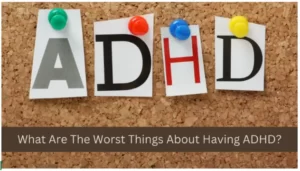
ADHD in Children – What You Must Know?
Childhood is the most beautiful time of everyone’s lives. It’s a time that is supposed to be filled with laughter, curiosity and unlimited energy.
Yet, for some children, this most beautiful time holds a different meaning. It’s filled with chaos and fun, but a different kind that leaves them confused about how they should navigate their emotions and well-being.
Attention deficit hyperactivity disorder (ADHD) paints a unique landscape of their experience, where focus flits like a butterfly, impulses tug like insistent weeds, and hyperactivity hums a constant background melody.
As parents, navigating this terrain requires love and knowledge, a directory to guide us through the challenges and celebrate our strengths. So, learn more about ADHD in children and everything you must know to ensure a certain future for your munchkins.
ADHD – Attention Deficit Hyperactivity Disorder
ADHD, once dejected in confusion and stigma, is now understood as a complex neurodevelopmental disorder. It affects brain regions responsible for attention, impulsivity, and hyperactivity, leading to a cascade of behaviours that can be puzzling for children and adults.
In easier words, your child’s brain is like a traffic signal. Sometimes, the green light stays on for a long time, and they can focus on one thing for a while. But other times, the red and yellow lights flicker on and off quickly, making it hard to stop and focus on what needs to be done. This is like when your child is impulsive or fidgety.
But ADHD is not merely a lack of focus or boundless energy. It’s a complex neurodisorder that has various aspects.
Some children struggle with inattentiveness, quickly drifting off into daydreams or losing track of tasks. Others grapple with impulsivity, blurting out answers before questions are finished or leaping into action without considering consequences.
Hyperactivity, a constant hum of motion, might have them fidgeting, squirming, or bouncing with irrepressible energy. But remember, these are just brushstrokes on the canvas, not the entirety of the painting. Every child with ADHD possesses unique behavior, expressing the disorder in their way.
ADHD in Children – 5 Crucial Keys for Parenting a Child with ADHD
While ADHD manifests differently in each child, some common themes tend to emerge. In the classroom, attention may flit like a butterfly from lesson to daydream, homework becomes a mountain of forgotten details, and social interactions can be fraught with impulsive outbursts or missed cues.
At home, routines can unravel, frustration explodes in meltdowns, and the constant movement can seem like a never-ending dance.
It’s important to remember that these challenges do not reflect the child’s intelligence or character. They are simply the natural melody of their ADHD playing out. While there are medicines like Adderall that can be used as a short-term treatment plan. Other ways can be used to manage their lifestyles as well.
As parents, your role is not to force the music to stop but to learn its rhythm, find harmony within the noise, and help our children discover the beautiful music they hold within. Understanding ADHD is the first step, but knowledge is useless without application.
Here are five valuable keys for parents navigating the choppy waters of ADHD:
-
Embrace the Diagnosis, Not the Stigma
A diagnosis of ADHD can feel like a storm cloud, but remember, it’s simply a label, not a limitation. Embrace it as a tool for understanding your child’s unique brain chemistry, a stepping stone to finding the support and strategies they need to thrive.
Try and understand their behavior. Do more research and talk to specialists. The more you know how your brain’s neurology works, the more you can help them navigate their thoughts.
-
Be a Team Player
You are not in this alone. Seek support from healthcare professionals, educators, and other parents. Build a team that understands your child and can work together to create a customized roadmap for success.
-
Positive Reinforcement, Not Punishment
Punishment won’t magically fix what’s happening in their brain and alter their chemistry. Instead, focus on positive reinforcement. Celebrate small successes and offer consistent, gentle guidance towards desired behaviors.
Remember, patience is a virtue, and they need as much patience as you can. Make them feel heard so they have no problem coming to you for support when they hit a wall.
-
Structure and Routine, the Essential Anchors
ADHD thrives on chaos, so structure and routine become essential anchors. Create predictable schedules, clear expectations, and consistent consequences. Visual aids, timers, and checklists can be your allies in this effort.
Figure out how impeccable organization can help out your child. Do your research and help them stay consistent with their schedules.
-
Celebrate the Strengths, Not Just the Struggles
ADHD is not just a list of deficits. It also comes with a bouquet of unique strengths. Children with ADHD may be brimming with creativity, boundless energy, and infectious enthusiasm. Cultivate these strengths, allowing them to blossom alongside the challenges.
Parting Thoughts
Remember, parenting a child with ADHD is a journey, not a destination. There will be days when the inner orchestra plays a discordant tune, and frustration threatens to engulf you. But amidst the noise, always remember the beautiful music your child holds within.
With understanding, support, and a dash of love, you can help them find their rhythm, dance to their melody, and discover the tune of their potential.
This is just the beginning of the conversation. As you navigate the landscape of ADHD, remember we are here as a resource, a sounding board, and a silent cheerleader. Together, let’s turn the challenges into opportunities, the chaos into harmony,


